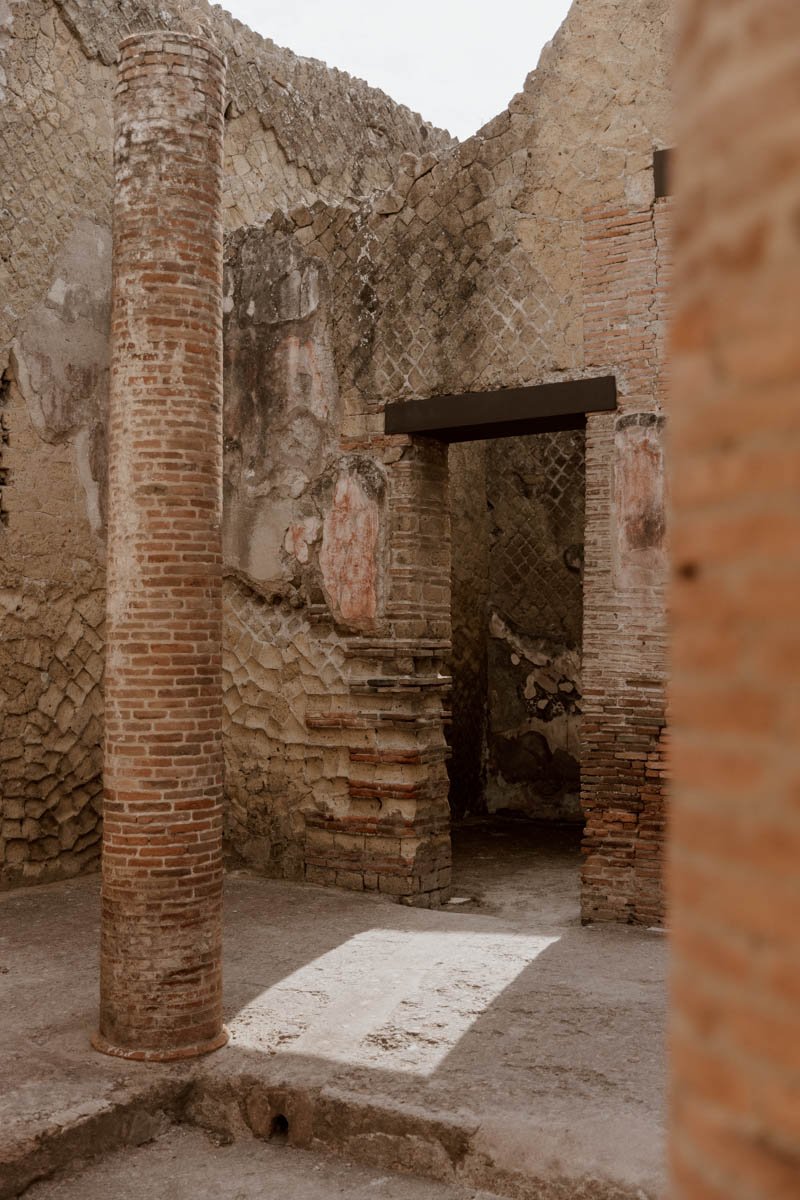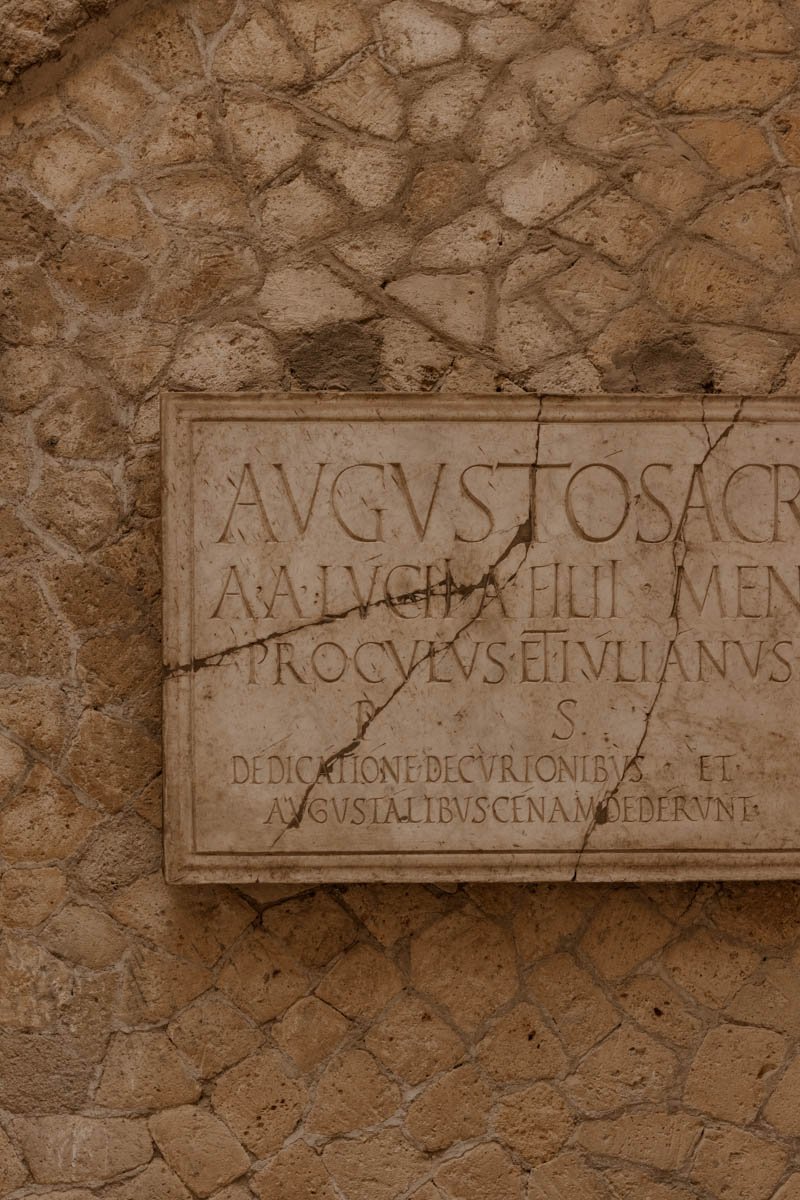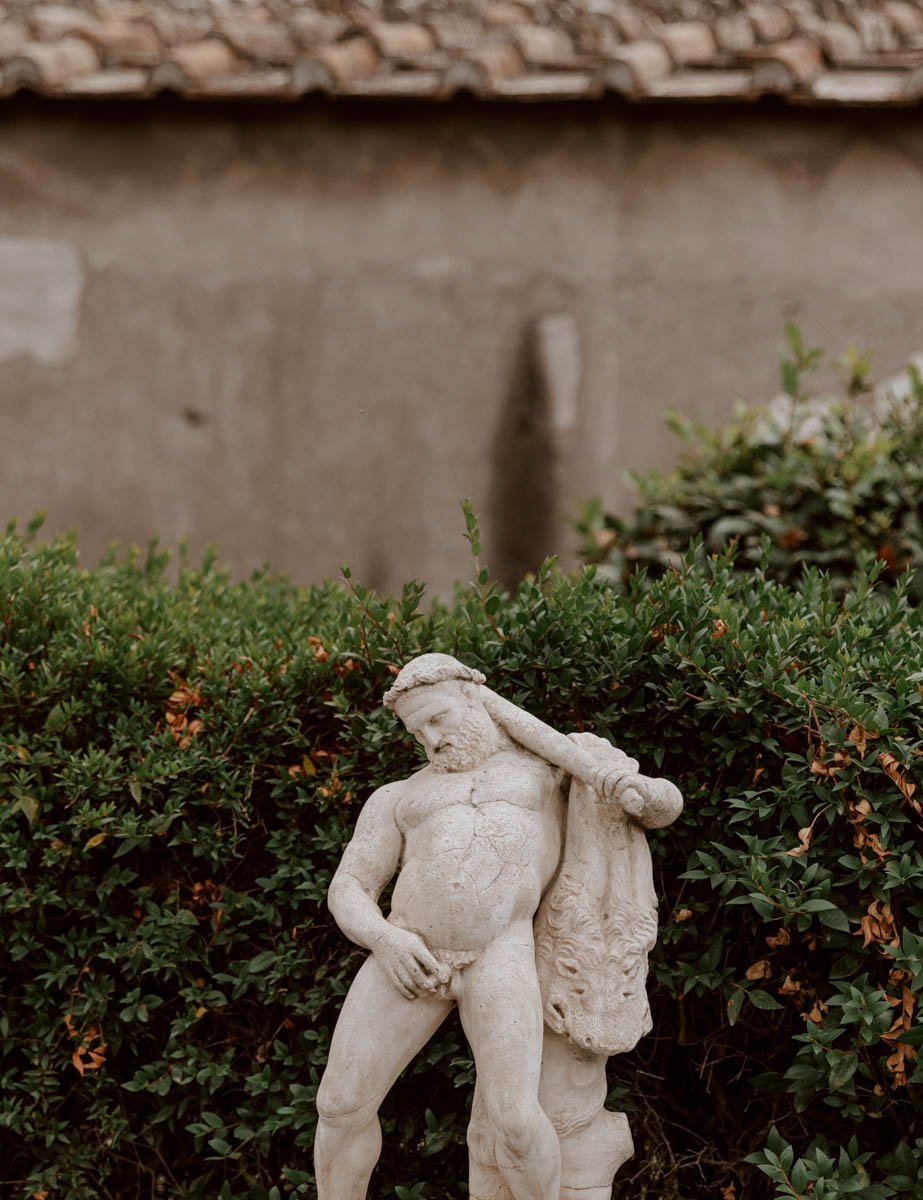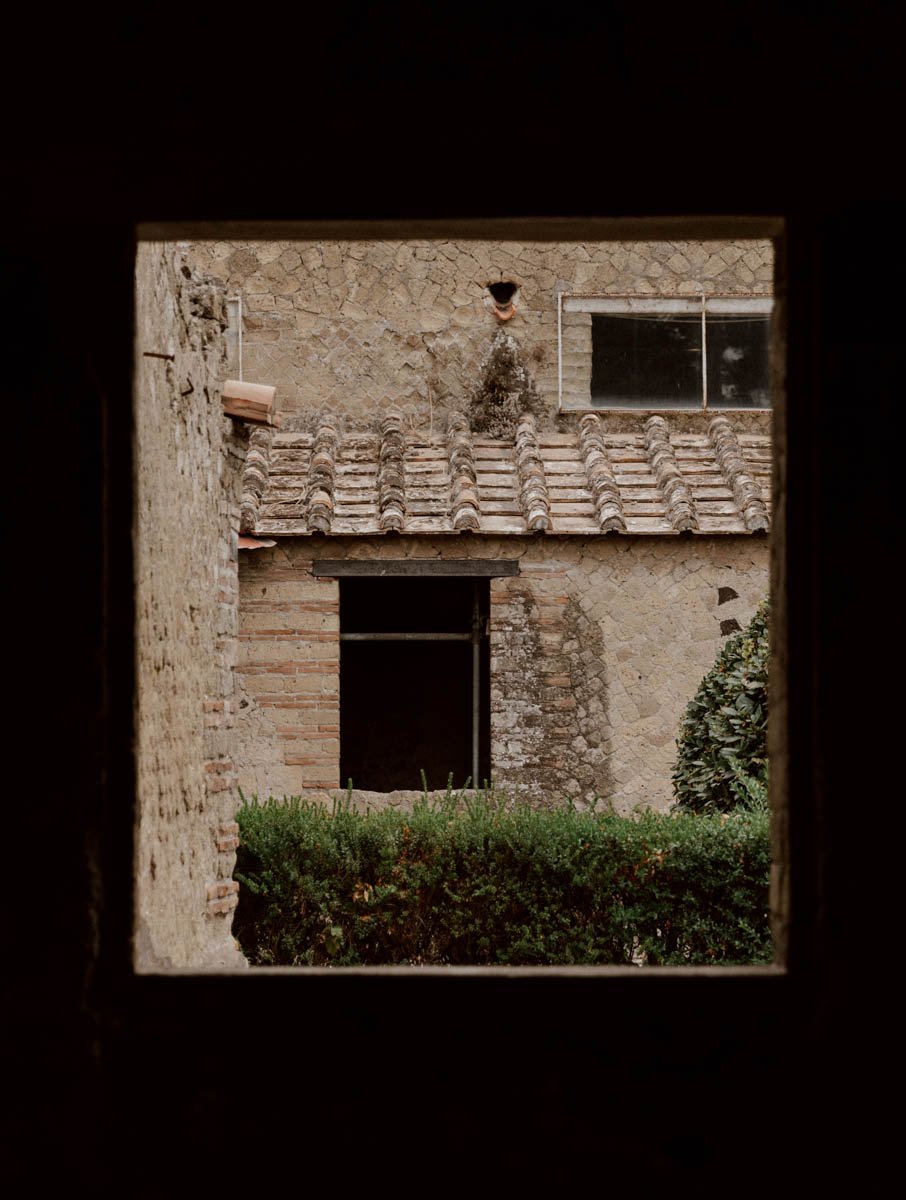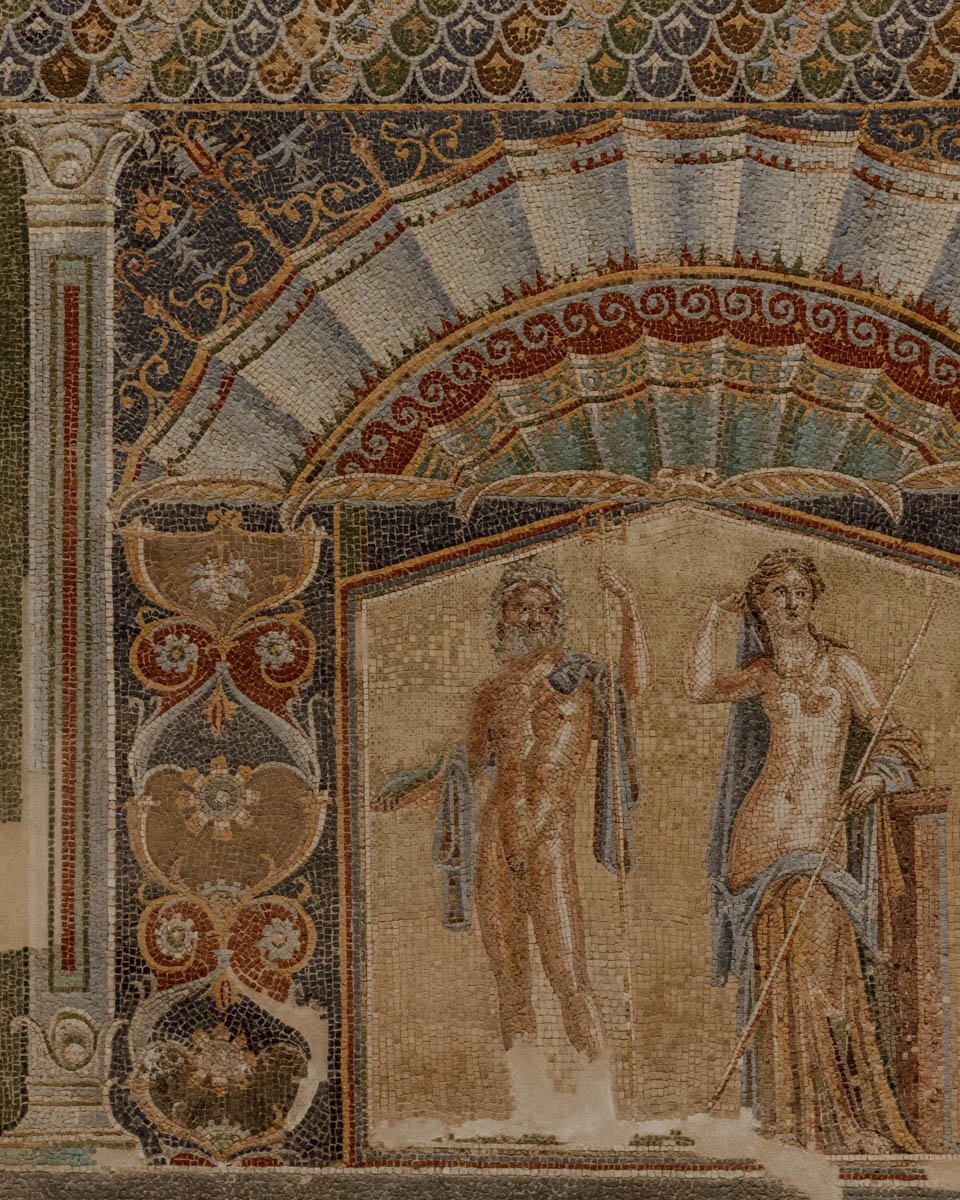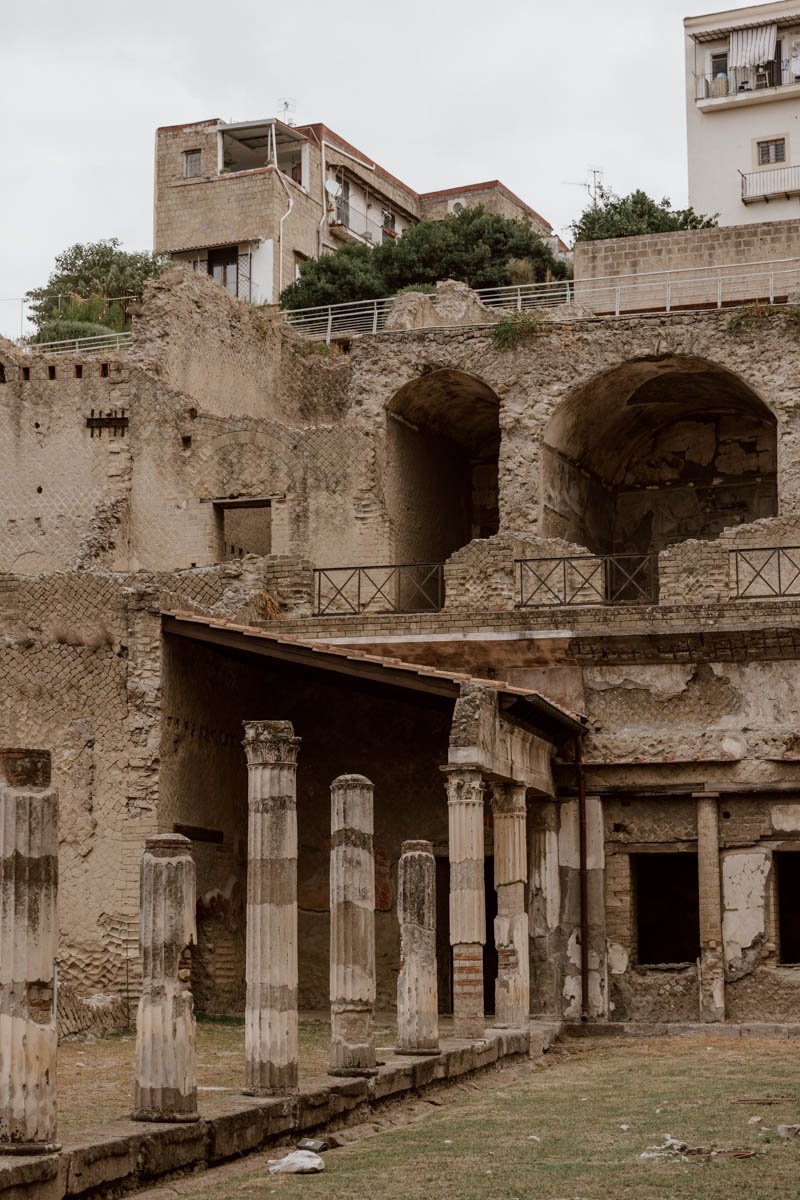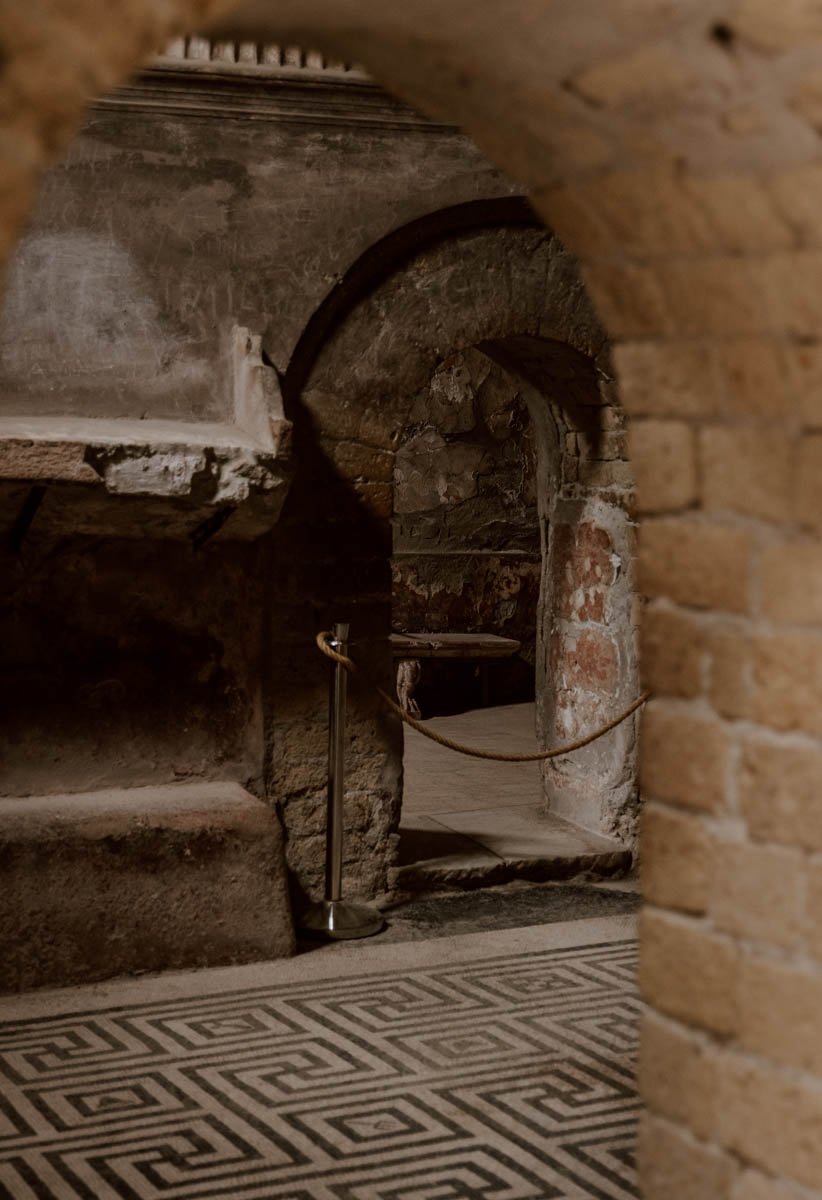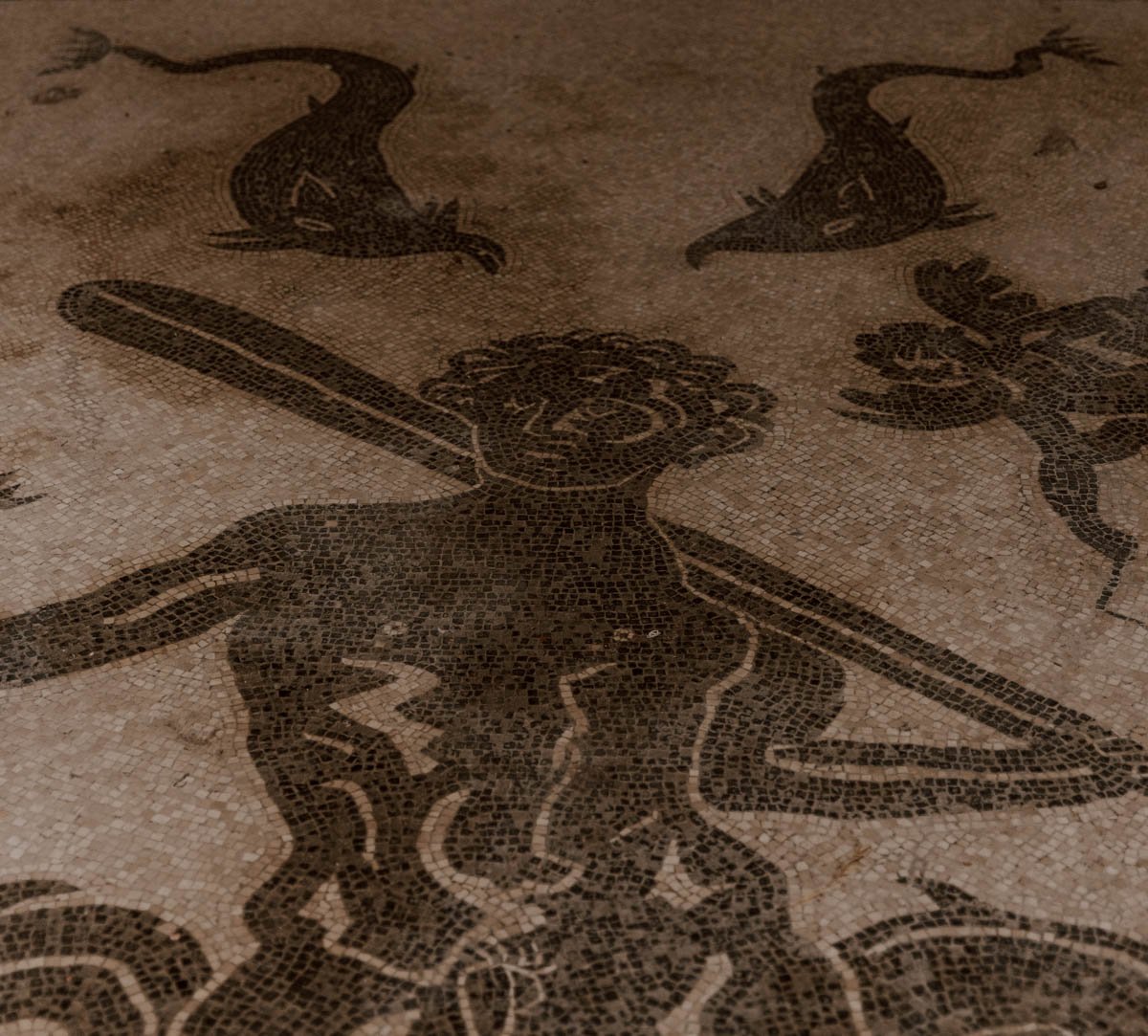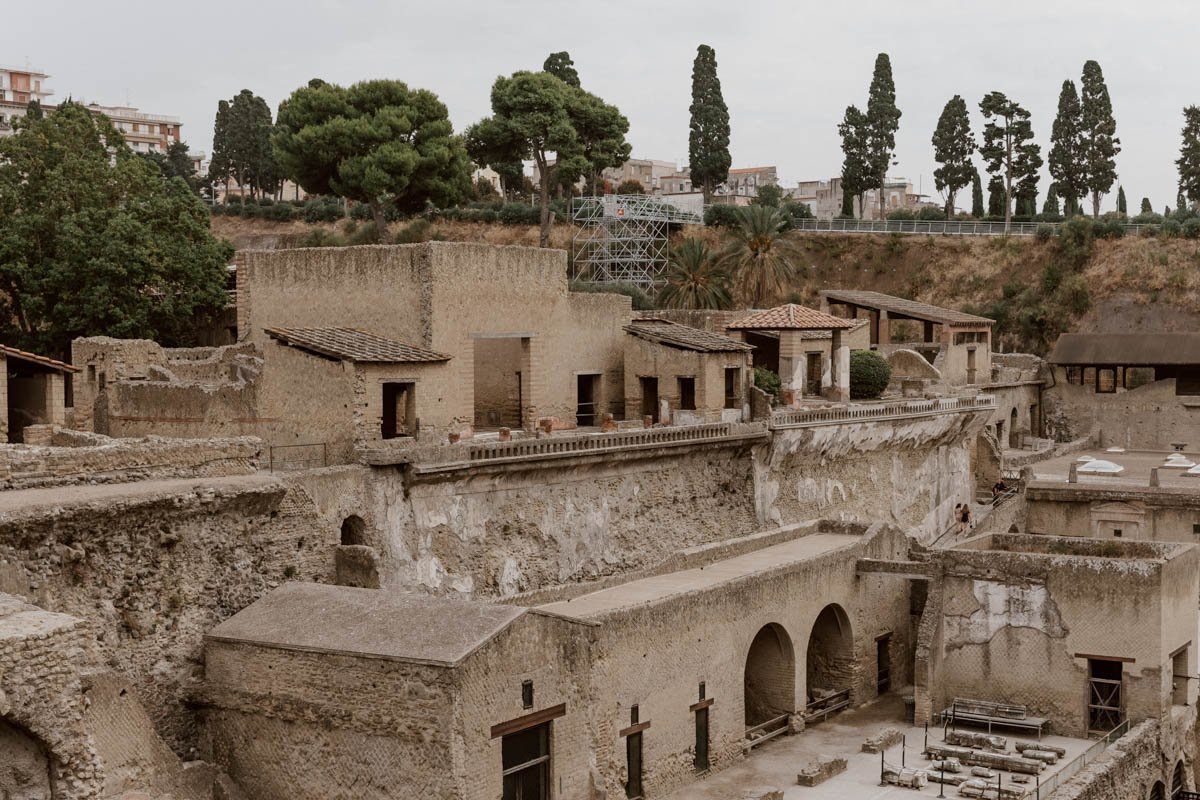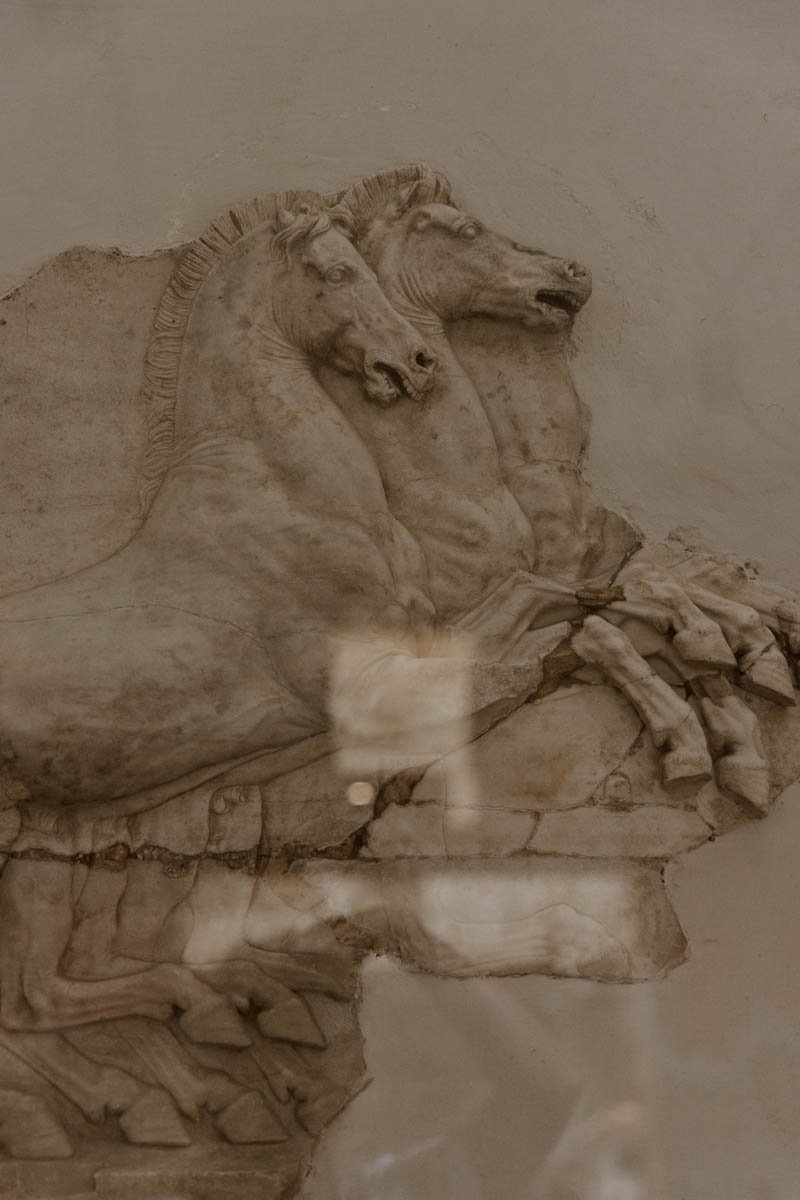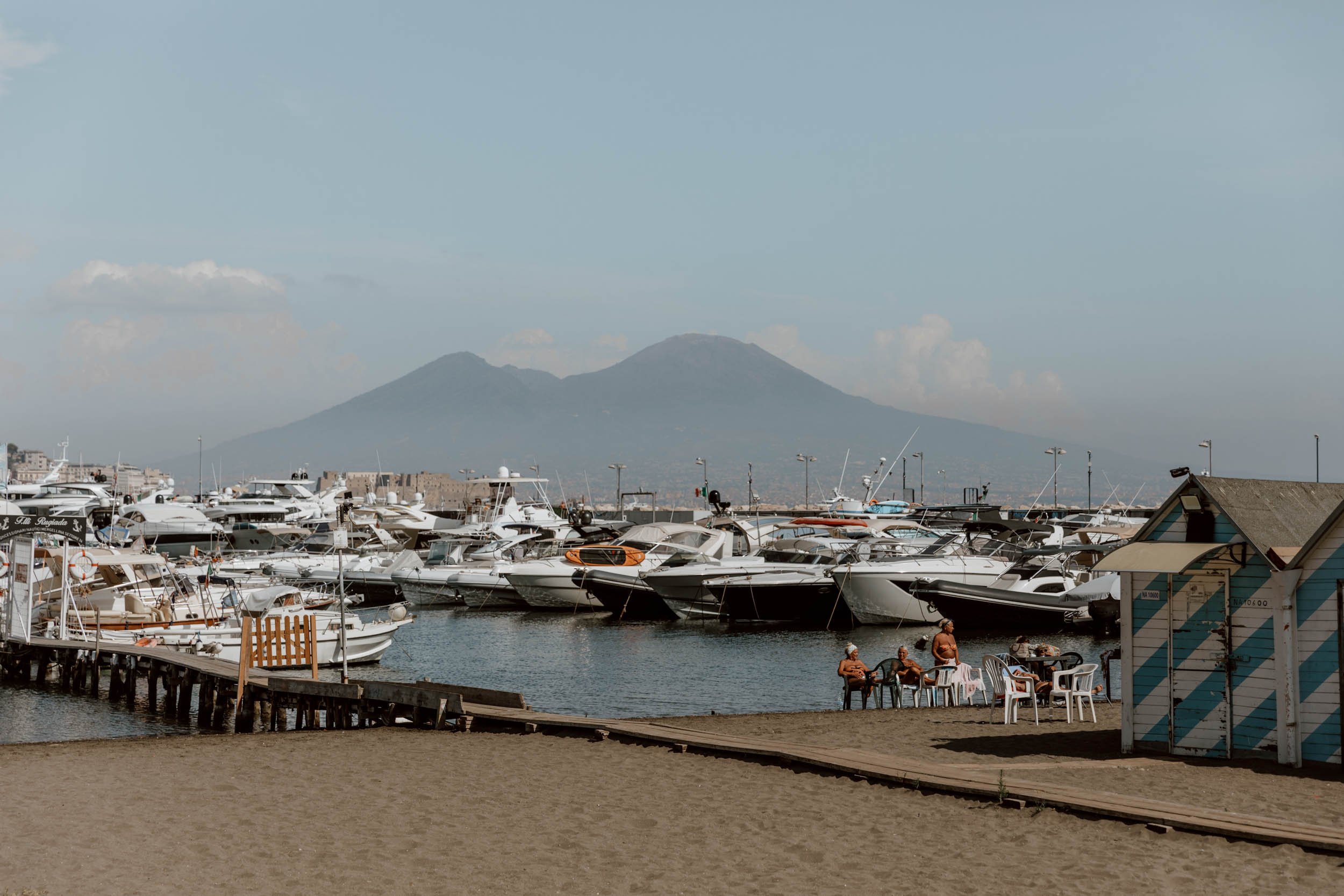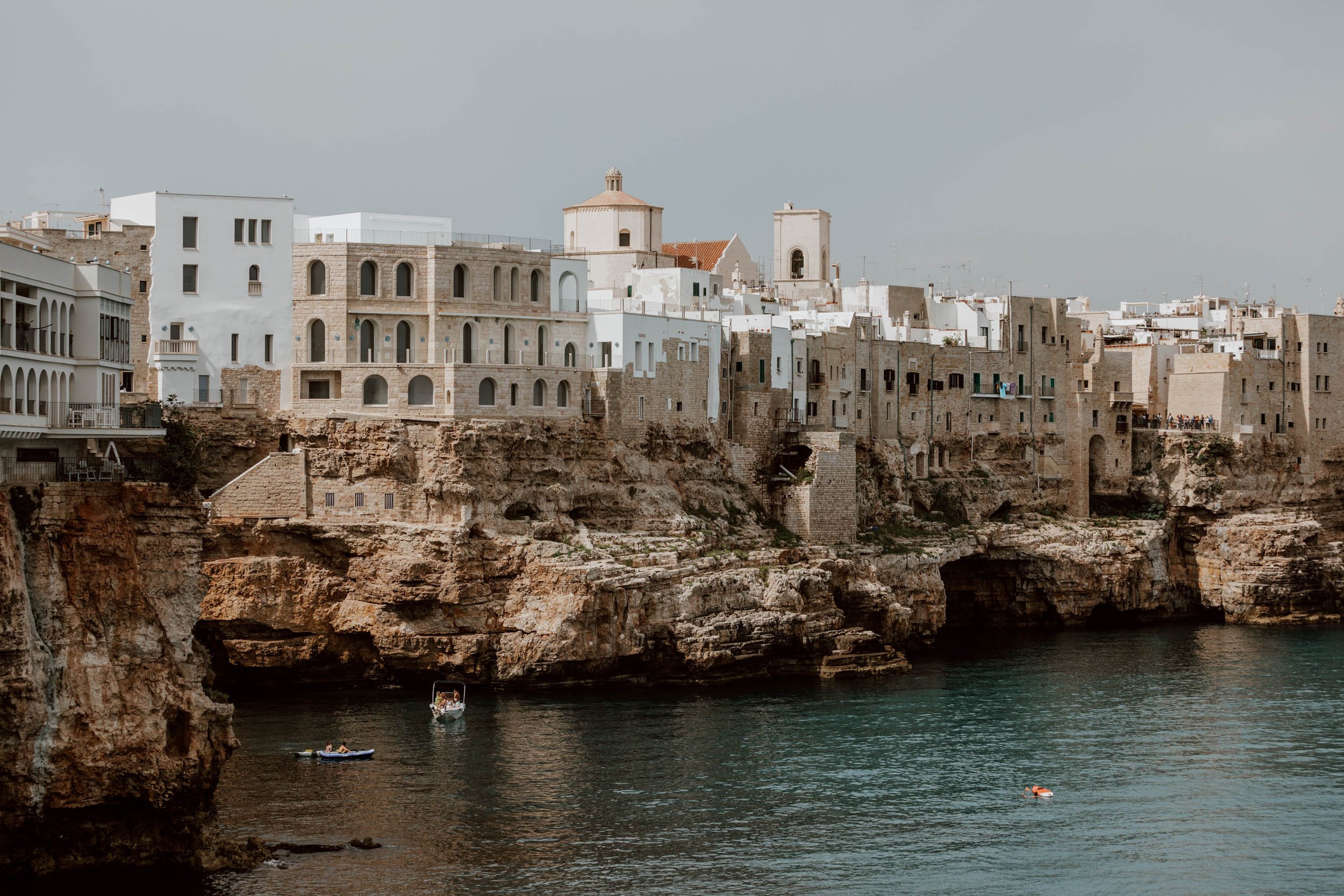Planning a day trip to Herculaneum? Our guide’s got you covered!
Buried deeper and sealed in more tightly than its better known neighbour, this Roman town named after a Greek hero continues to reveal itself slowly to the modern world.
Cracked by an earthquake seventeen years before Mount Vesuvius erupted in a cataclysmic fit of anger, the honeycomb walls of Herculaneum still bear the scars of nearly two thousand years ago.
Within them, for some, the whispers of the ancient world are louder and crisper here than anywhere else.
Just 10 miles away from Pompeii, this smaller and exceptionally well preserved town trapped between the sea and volcanic foothills, suffered the same fate in 79 AD: Vesuvius blew its top and the pyroclastic flow simultaneously destroyed and preserved Herculaneum twenty metres deep.
Discovered in the 18th century, under threat in the1990s, and now steadily emerging out of the shadow of Pompeii, a morning or afternoon in the quieter and lesser-visited Herculaneum really does allow one to step back in time.
Too many travellers pit the two UNESCO World Heritage sites against each other, or make unfair comparisons between them, when they instead they should be viewed as two essential parts of a Neapolitan Roman trilogy alongside the treasures found in the Museo Archeologico Nazionale di Napoli.
In this guide, we’ve shared the essential context and practical travel advice to help you plan your own day trip to Herculaneum. From the historical background and advice on transport connections from Naples and Sorrento, to tips on tickets, tours, its unmissable places and works, whether to pair it with Pompeii or Vesuvius, you’ll find everything you need to give you the best experience of the archaeological site.
We’ll also give you a clear answer on the age-old question of whether you should visit Herculaneum or Pompeii if you’ve only got time for one.
This is our guide to visiting Herculaneum.
the herculaneum essentials
What / A Roman town buried by Vesuvius in 79AD, now a UNESCO World Heritage Site
Where / In Ercolano, just 30 minutes by train from Naples, an hour from Sorrento.
When / Open 7 days, 8.30am to 7.30pm in summer
Time / Two to three hours required for the site
Tickets / €13 full-price, €2 reduced, or included in the Naples Pass
See / Mosaics, frescoes, and incredibly well-preserved villas and streets
Do / A small-group tour with an archaeologist
Pair / The hike up Vesuvius or do a combined tour with Pompeii
The Burial & Discovery of Herculaneum
The eruption of Mount Vesuvius in 79 AD killed several thousand people, and destroyed towns and settlements in the Gulf of Naples.
It also preserved the greatest insights we have into life in Ancient Rome.
Herculaneum, then a prosperous and densely populated little resort town by the sea, suffered the same tragic fate as neighbouring Pompeii, save for one critical difference.
It was on the other side of the furious volcanic explosion.
Where Pompeii was covered by a 9 metre layer of porous pumice, Herculaneum’s location saw it buried deep under a 20-25 metre mass of mud and pyroclastic flow, whilst the heat from volcanic gases carbonised wood, paper, bread, beds, and boats.
Trapped in this airtight seal under hardened tufa rock for two millennia meant that, like a fly in amber, Herculaneum was the better preserved of the two.
However, these conditions - plus the fact that a town had been built on top of most of it in the intervening centuries - made excavations of Herculaneum much more challenging and staggered than its sister site.
The story goes that, after it was accidentally discovered in 1709 by workers building a well for a monastery, the first rudimentary digs at the behest of a commander with the Austrian army were heavy-handed and motivated by greed as much as curiosity. The first systematic excavations started in 1738 under the more scrupulous guise of Karl Weber, but these were shelved after the discovery of Pompeii in 1748 piqued the interest of the King of Naples, with Herculaneum put on the back burner for nearly a century.
What we now know as ‘archaeology’ wasn’t really a thing then, and it was the discovery of Herculaneum and Pompeii which created the science and the job description, so everyone was sort of making it up as they went along here. This means several serious mistakes and damage across the decades but, with lessons learned and techniques improved, the excavation of Herculaneum resumed in earnest in 1828.
Ercolano & Herculaneum | A Town of Two Names
We're going to cause some temporary confusion so you can avoid it when you arrive.
The Italians know Herculaneum as 'Ercolano'. Depending on the legend you believe, the name comes from Hercules, the ripped Greek hero, founding the town or, more likely, it being named in his honour.
However, the town which the Archaeological Park of Herculaneum is located within (and the majority of ruins still lie underneath) is also called Ercolano.
It wasn’t originally called that though, with its name changed from Resina in the 1960s to improve tourism.
The town of Ercolano is the place many of you will be travelling to by train, and the correct station to buy a ticket for is 'Ercolano Scavi', which translates as the 'Ercolano excavations'.
But the station is 10-minute walk from the actual excavations, and will sometimes be listed or announced on train tickets and journeys simply as 'Ercolano'.
So, in order to go to Herculaneum, you need to go to Ercolano.
In this guide we'll stick to the English exonym for the ruins, and when we refer to 'Ercolano' we're always talking about the modern town which overlooks the site.
You can find the entrance to the ruins here on Google Maps.
Note that the site has different opening hours in summer & winter: from 16th March to 14th October it’s 8.30am - 7.30pm, and winter months it closes at 5pm. Last entry is 90 minutes before closing.
It's A Half-Day Trip From Naples or Sorrento
It's really easy and affordable to independently visit Herculaneum on a day trip with public transport from your base Naples, Sorrento, or elsewhere on the Amalfi Coast.
As the site only requires two or three hours, you don't have to set off super early, and can choose to do it in the morning or an afternoon depending on conditions, hangovers, and other plans.
The EAV Circumvesuviana train from Naples' Garibaldi & Porta Nolana stations costs €2.60 for the 20-minute journey, whilst the same train from Sorrento takes an hour.
This is also the main line to bring travellers to Pompeii, so it can become very busy. Those looking for a less crowded, more comfortable train ride should make sure they board the line from Naples which terminates in Torre Anunziata, rather than Sorrento, or opt to pay extra to board the less frequent tourist-centric Campania Express (€15 one-way, €25 return).
We've explained the differences further, plus shared step-by-step details and travel tips for a smoother journey, in this post: How To Get To Herculaneum from Naples.
Of course, you can also opt to join a tour which includes pick-up and round-trip transport from Naples or Sorrento, as well as your guide within Herculaneum. The below are highly-rated:
· Half-Day Guided Trip from Naples
· Half-Day Herculaneum Tour From Sorrento
Before finalising any transport or tours though, you need to work out if you're going to pair Herculaneum with its more famous neighbour or a walk up the volcano which caused all this bother in the first place - we've shared more advice on how to do this (and whether you should) later in the post.
If you’re doing a road trip in Italy, then you’ll be happy to know that the official car park is just a two-minute walk from the ticket office, costing €2/hour - find it here on Google Maps. That will be the easiest option, but you can also try to nab a free space about a 10-miunute walk from the entrance (maps)
Travel Tip // The entrance to the Archaeological Park (maps) is a 7-10 minute walk from the Ercolano Scavi train station (maps). You'll find a handful of restaurants outside the train station that try and drum up business quite vocally; it's best to avoid these as they have a reputation for overcharging and poor quality. If you want to grab breakfast in Ercolano, you'll find better options on the street closer to the entrance (and for lunch we highly recommend a bit of a splurge at Pappamonte - the puttanesca was exceptionally delicious! Find it here on Google Maps)
Where To Buy Herculaneum Tickets
No reservation or time slot is required and, unlike Pompeii, you don't need to worry as much about buying tickets in advance or queues.
Whilst you can't guarantee that there won't be any lines or queues at the ticket office, they won't be as long or slow as those you'll find in the more popular Pompeii.
There is however a dedicated line and entrance for visitors with skip-the-line advance tickets, and one for purchases on the day, so if you know you’re arriving in peak summer after 9am, it’s not a terrible idea to save a bit of time.
Prices in 2024 are as follows:
Full Price | €13
Reduced | €2 for EU/EC citizens aged 18-25 (proof required), free for under 18s
If you wish to buy Herculaneum tickets in advance, you can do it online via the official website. It's only in Italian, but the official tickets page is available here in English.
Alternatively, you can buy skip-the-line-tickets with 24-hour cancellation here
Note that entry to Herculaneum is free on first Sunday of the month, when reservations are not required and cannot be made online.
If buying in advance online, it’s a good idea to have the tickets downloaded to your phone before arrival.
Travel Tip // Before you purchase tickets, if you are planning to spend a few days in Naples (which you absolutely should as it's one of our favourite cities in the world), then you should also checkout a couple of government-run tourism passes which include your Herculaneum tickets.
Although these deals can sometimes be quite crap, these two can actually save you quite a bit of money overall if you plan on visiting several of the attractions included in the package (including Pompeii, the National Archaeology Museum, Royal Palace of Caserta, and Museo Capodimonte)
Find out more about the Naples Pass and Campania Artecard - or get lots more inspiration first with 19 Wonderful Things To Do In Napoli.
You Only Need Two or Three Hours
A real positive of Herculaneum is that you cover all of the site at a reasonable pace and get to know everything quite intimately.
We spent three hours here, and were even able to linger and return to several of our favourites, but two hours is the minimum amount of time you should set aside for it.
As it’s so compact there’s also no need to head out for lunch and return (which people should consider if spending a full-day at Pompeii).
Personally, we can’t imagine anyone but the most passionate or curious spending more than four hours here, meaning Herculaneum is an ideal half-day trip from Napoli, leaving you time to do some more things back in the city, or in the morning before arriving for an afternoon visit.
It also opens up the chance to combine it with a visit to either Pompeii or Mount Vesuvius on the same day, and we’ve shared more advice on when and how to do that later in the post.
The Unmissables of Herculaneum
The compact size of the site means you don’t have to stress too much about planning a specific route or rushing around to cover off the highlights of Herculaneum.
Amongst the honeycomb brick, pillars, and cobblestone streets, you can uncover vibrant frescoes and intricate mosaics, baker’s jars, pizza ovens and wine lists, and pop into remarkably modern changing rooms, luxurious living quarters, and opulent villas. As Andrew Wallace-Hadrill explains in The Other Pompeii: Life and Death in Herculaneum, you don’t need as much guesswork as Pompeii to work out what a place or space was used for.
It is however very important to remember that Herculaneum and much of Roman society, despite how incredibly modern and similar it feels in so many ways, was underpinned by slavery. Interestingly though, it is thought that up to 80% of Herculaneum’s male citizens were ex-slaves.
We’ve shared our favourite sights and places below, alongside their numbered location in the site, to make certain you don’t miss them!
1. The Ancient Beach and The Skeletons of Vesuvius’ Victims - the largest collections of skeletons from anywhere in the ancient world
9. The House of the Bicentenary
11. The Tavern with a wine advertisement (bottega ad cuccumas)
12. The House of The Black Saloon (casa del salone nero)
14. The spectacular frescoes in the College of the Augustales (sede deli augustali)
25. The Samnite House (casa sannitica)
26. The immaculate and intricate Women’s Section of The Central Baths (terms central feminini)
27. The incredible mosaic in The House of Neptune & Aphrodite (casa di nettuno e anfitrite)
30. The stunning House of The Wooden Screen (casa del tramezzo di legno)
Also, don’t miss the small building housing a large carbonised ship.
Due to important conservation and archaeological works, closure of certain houses or areas are common in Herculanum. This is understandable but can cause frustration, and one of the most important places in the site was closed off for our visit. The Villa of the Papyri is thought to have been one of the most luxurious houses in the Roman world, and responsible for many of the art works you’ll see in the National Archaeological Museum of Naples (MANN). It’s also where the The Herculaneum papyri were discovered in the18th century, arguably the most important discoveries across all Roman sites. These mysterious scrolls were carbonised by the pyroclastic flow of Vesuvius and, tantalisingly, it has long been the hope that technology will one day allow us to read them and discover thousands of lost and unknown original classical texts.
We’re also closer than we’ve ever been before, something The Smithsonian goes in-depth about in this article.
Did You Know // A lot of, quite literally, interesting shit has been found in Herculaneum. The faeces discovered in drains and sewers allowed the experts to learn much more about the Roman diet and daily life. Et poo Brutus?
The Numbers & Layout Are ConfusING
Herculaneum is split into four main blocks, more rational and more reminiscent of modern American urban planning than the sclerotic, labyrinthine layout of Europe’s old towns. It adds to the bizarre sense we felt throughout, with such uniformity and conformity across the diamond patterned bricks and structures and streets, that this place just does not feel as old as it is in so many ways.
It took a while for us to get our heads around the layout, so we wanted to share some important points to consider for your own trip below:
· All the buildings and main places of interest are numbered, but the numbers don’t necessarily correspond with route that you’ll follow around Herculaneum.
· Even following the grid system and numbers, you’ll have to double back on yourself a few times to ensure you visit every place / room within the site. This may feel counter-intuitive, but trust us that there’s no other way around it.
· To make things more confusing, there are very few direction signs, and most of the signs that do exist point to specific locations rather than a number of the place.
· For this reason, it really is essential for self-guided visits to buy the map at the ticket office. Annoyingly, they charge €1 extra for this.
· However, even with the map, you may still get confused about whether you already visited that street or went in that house via a different entrance.
· The numbers used in the map and on the sites do not correspond with the numbers listed for the audio guide at each place - which adds to the confusion.
However, don’t worry. All you need to do is get the map, freestyle a little, and make sure you go down each street (and each side of each street), and enter each open door you find, and you’ll still cover everything.
Herculaneum Tour Guides & Reading
There are very few explainers / information boards with the Archaeological Park: this is a positive for the aesthetic and conservation, but not so great for the curious traveller.
There is however a wonderfully friendly cat.
If you really want to bring the ruins and the stories more to life, and get more context to what you’re seeing, then it’s essential to either do some research or reading before you arrive, rent the audioguide at the entrance, or explore Herculaneum with a guide.
Guides & Audioguides
Unlike Pompeii, there weren’t a lot of hustle tour guides outside when we visited, so it’s best to arrange one in advance of your arrival.
The following are very highly-rated, meet you at the site, and include free 24-hour cancellation if plans change before your dates:
· Herculaneum group tour with an archaeologist
· A private tour with an archaeologist
· A small-group tour of Herculaneum
Alternatively, downloading an Audioguide is a really good idea. You can order them in advance online and collect them at the ticket office, or alternatively just request one when you arrive. The price is €10 per audioguide.
Resources
If you watch one thing before you visit, it should be The Other Pompeii: Life and Death in Herculaneum. It’s an excellent 45-minute BBC documentary available on Youtube. It’s presented by Professor Andrew Wallace-Hadrill, one of the foremost authorities on the site and a leading member of the Herculaneum Conservation Project.
You Can Pair It With Pompeii…
It is 100% possible to visit both sites in one day independently or with a tour, but we don’t recommend it for everyone.
If you’ve got a keen interest in history, the Romans, or archaeology, you’re better off spreading them out over two days. Pompeii deserves more than two or three hours, and you will regret having to rush and leave early.
As you’ll likely also be spending time in the MANN back in Naples, the most efficient way to do it would involve a full-day in Pompeii, and then visiting Herculaneum and MANN on a separate day.
If standalone day-trips are right for you, you may even prefer to base yourself in the new town of Pompeii or in Ercolano, rather than taking the train from Napoli Centrale or the Amalfi Coast.
For travellers on a tighter schedule who really do want to visit the highlights of both Roman sites in a single day, you have two options:
Take the 20 to 30-minute train between them, but note you may need to switch at Torre Annunziata. The Campania Express is more expensive, but offers quicker direct connections.
If doing the trains, we suggest starting the day early to optimise time at each, and opting for a guide to accompany you at one or the other.
Join a combined Pompeii and Herculaneum tour. These are a popular option from Naples, including round-trip transport to and between the sites, as well as an English-speaking guide at each, usually providing 2-3 hours in Pompeii and 2 hours in Herculaneum.
This small-group tour from Naples is highly-rated and led by an archaeologist guide, but you can also opt do it with a more expensive private tour.
Alternatively, check out this highly-rated combined tour which requires you to first meet your guide at Pompeii and they take care of onward transport to Herculaneum.
…Or Visit Vesuvius On The Same Day
The most convenient option to pair with Herculaneum, both for experience and logistics, is a walk up Mount Vesuvius.
The Vesuvius Express bus departs right next to Ercolano Scavi train station, bringing you up to the start of the trail in about 30 minutes, so you can opt do visit Vesuvius in the morning and then go to Herculaneum, or do it the other way round.
You can find more information and buy tickets for the Vesuvius Express here, whilst we’ve written a dedicated post on hiking Mount Vesuvius.
Alternatively, you can opt to do a guided tour which combines both sites with round-trip transport: Herculaneum + Vesuvius Day Trip from Naples.
Should You Visit Herculaneum or Pompeii?
This guide is about helping to you to decide on or shape your Herculaneum visit, rather than going in-depth on Pompeii (we did that in this guide).
However, comparisons are always made between the two most important archaeological sites in Italy due to their proximity and shared fate. So, we do need to answer this key question!
Whilst anyone with a keen interest in the Romans, classics, or archaeology should absolutely try to visit each, most travellers exploring Naples for only a few days will have to make a decision on whether to visit one or both of the UNESCO World Heritage sites.
Importantly, neither is 'better' than the other, with each being an incredibly important and complementary part of the same story, offering a great deal of insight for the curious traveller. Some of the key differences are however archaeological, structural, conservational in nature - and perhaps not as striking or clear to the traveller who isn't a classicist or that passionate about the subjects. In fact, we felt the differences between the two are perhaps now emphasised to such an extent that you will actually be surprised / let down by how similar they are in many ways, with the presence of second floors, balconies, and wood at Herculaneum perhaps not having the ‘wow’ factor for most.
There are some key practical differences though:
· Pompeii is much larger, requiring at least 4 hours / half a day and more energy to meaningfully explore.
· As you only need 2-3 hours for Herculaneum, the reduced amount of walking and energy required makes it a more pleasant experience in the heat of the Italian summer.
· Pompeii is one of the most famous places in Europe and receives significantly more visitors each day. This means lines are longer, tour groups larger, and crowds much more common.
· It’s easier to see and appreciate more of Herculaneum due to its compact size and layout. This means it’s carved out a reputation for offering a more intimate, less stressful, easier to get around, and a more enjoyable experience, especially when people are visiting both of them in quick succession. Indeed, this is often one of the key reasons people talk about preferring Herculaneum, as much as the frescoes, the skeletons, and the ruins.
Does that mean you should skip Pompeii in favour of Herculaneum? For us, it’s a hard no.
It took us two trips to Naples to visit both, and we always felt stupid for not prioritising time for Herculaneum on the first one. This was especially the case when our friends from home told us how much better it was, and we read so many reports of how underrated and underappreciated it was amongst tourists. Consider it the hipster Roman ruin of choice, or that it is often talked about as being criminally underrated and under-visited in comparison, that it has become a little over-rated in some discussions.
We found Pompeii to be more striking and, in all honesty, more beautiful and aesthetically interesting. Having now visited both several years apart, it was undoubtedly Pompeii which left a grander, more indelible impression on us.
For us, if you can only visit one, you will have more regret if you choose Herculaneum over Pompeii.
By the way, we 100% advise against taking any tour which lets you see the holy trinity of Vesuvius and the two archaeological sites in a single day - you’ll spread yourself too thin, miss out on too much, and there’s also the inevitable law of diminishing interest and returns.
Where to Next?
19 Wonderful Things to Do in Naples
How to Get From Naples to Herculaneum
23 Things to Know Before You Visit Naples (published soon)
The Best Day Trips From Naples





